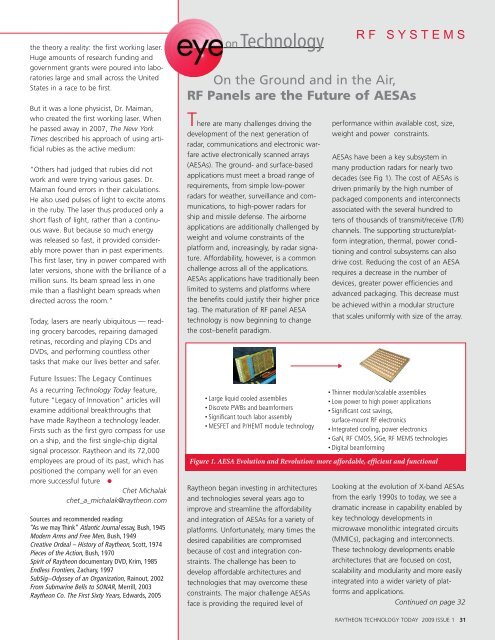2009 Issue 1 - Raytheon
2009 Issue 1 - Raytheon
2009 Issue 1 - Raytheon
Create successful ePaper yourself
Turn your PDF publications into a flip-book with our unique Google optimized e-Paper software.
the theory a reality: the first working laser.<br />
Huge amounts of research funding and<br />
government grants were poured into laboratories<br />
large and small across the United<br />
States in a race to be first.<br />
But it was a lone physicist, Dr. Maiman,<br />
who created the first working laser. When<br />
he passed away in 2007, The New York<br />
Times described his approach of using artificial<br />
rubies as the active medium:<br />
“Others had judged that rubies did not<br />
work and were trying various gases. Dr.<br />
Maiman found errors in their calculations.<br />
He also used pulses of light to excite atoms<br />
in the ruby. The laser thus produced only a<br />
short flash of light, rather than a continuous<br />
wave. But because so much energy<br />
was released so fast, it provided considerably<br />
more power than in past experiments.<br />
This first laser, tiny in power compared with<br />
later versions, shone with the brilliance of a<br />
million suns. Its beam spread less in one<br />
mile than a flashlight beam spreads when<br />
directed across the room.”<br />
Today, lasers are nearly ubiquitous — reading<br />
grocery barcodes, repairing damaged<br />
retinas, recording and playing CDs and<br />
DVDs, and performing countless other<br />
tasks that make our lives better and safer.<br />
Future <strong>Issue</strong>s: The Legacy Continues<br />
As a recurring Technology Today feature,<br />
future “Legacy of Innovation” articles will<br />
examine additional breakthroughs that<br />
have made <strong>Raytheon</strong> a technology leader.<br />
Firsts such as the first gyro compass for use<br />
on a ship, and the first single-chip digital<br />
signal processor. <strong>Raytheon</strong> and its 72,000<br />
employees are proud of its past, which has<br />
positioned the company well for an even<br />
more successful future<br />
Chet Michalak<br />
chet_a_michalak@raytheon.com<br />
Sources and recommended reading:<br />
“As we may Think” Atlantic Journal essay, Bush, 1945<br />
Modern Arms and Free Men, Bush, 1949<br />
Creative Ordeal – History of <strong>Raytheon</strong>, Scott, 1974<br />
Pieces of the Action, Bush, 1970<br />
Spirit of <strong>Raytheon</strong> documentary DVD, Krim, 1985<br />
Endless Frontiers, Zachary, 1997<br />
SubSig−Odyssey of an Organization, Rainout, 2002<br />
From Submarine Bells to SONAR, Merrill, 2003<br />
<strong>Raytheon</strong> Co. The First Sixty Years, Edwards, 2005<br />
onTechnology<br />
On the Ground and in the Air,<br />
RF Panels are the Future of AESAs<br />
There are many challenges driving the<br />
development of the next generation of<br />
radar, communications and electronic warfare<br />
active electronically scanned arrays<br />
(AESAs). The ground- and surface-based<br />
applications must meet a broad range of<br />
requirements, from simple low-power<br />
radars for weather, surveillance and communications,<br />
to high-power radars for<br />
ship and missile defense. The airborne<br />
applications are additionally challenged by<br />
weight and volume constraints of the<br />
platform and, increasingly, by radar signature.<br />
Affordability, however, is a common<br />
challenge across all of the applications.<br />
AESAs applications have traditionally been<br />
limited to systems and platforms where<br />
the benefits could justify their higher price<br />
tag. The maturation of RF panel AESA<br />
technology is now beginning to change<br />
the cost–benefit paradigm.<br />
Large liquid cooled assemblies<br />
Discrete PWBs and beamformers<br />
Significant touch labor assembly<br />
MESFET and P/HEMT module technology<br />
<strong>Raytheon</strong> began investing in architectures<br />
and technologies several years ago to<br />
improve and streamline the affordability<br />
and integration of AESAs for a variety of<br />
platforms. Unfortunately, many times the<br />
desired capabilities are compromised<br />
because of cost and integration constraints.<br />
The challenge has been to<br />
develop affordable architectures and<br />
technologies that may overcome these<br />
constraints. The major challenge AESAs<br />
face is providing the required level of<br />
RF SYSTEMS<br />
performance within available cost, size,<br />
weight and power constraints.<br />
AESAs have been a key subsystem in<br />
many production radars for nearly two<br />
decades (see Fig 1). The cost of AESAs is<br />
driven primarily by the high number of<br />
packaged components and interconnects<br />
associated with the several hundred to<br />
tens of thousands of transmit/receive (T/R)<br />
channels. The supporting structure/platform<br />
integration, thermal, power conditioning<br />
and control subsystems can also<br />
drive cost. Reducing the cost of an AESA<br />
requires a decrease in the number of<br />
devices, greater power efficiencies and<br />
advanced packaging. This decrease must<br />
be achieved within a modular structure<br />
that scales uniformly with size of the array.<br />
Thinner modular/scalable assemblies<br />
Low power to high power applications<br />
Significant cost savings,<br />
surface-mount RF electronics<br />
Integrated cooling, power electronics<br />
GaN, RF CMOS, SiGe, RF MEMS technologies<br />
Digital beamforming<br />
Figure 1. AESA Evolution and Revolution: more affordable, efficient and functional<br />
Looking at the evolution of X-band AESAs<br />
from the early 1990s to today, we see a<br />
dramatic increase in capability enabled by<br />
key technology developments in<br />
microwave monolithic integrated circuits<br />
(MMICs), packaging and interconnects.<br />
These technology developments enable<br />
architectures that are focused on cost,<br />
scalability and modularity and more easily<br />
integrated into a wider variety of platforms<br />
and applications.<br />
Continued on page 32<br />
RAYTHEON TECHNOLOGY TODAY <strong>2009</strong> ISSUE 1 31

















